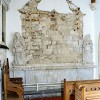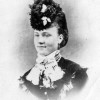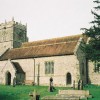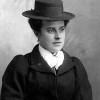The parish church dedicated to St. Andrew sits in beautiful and mostly wooded countryside in the Cerne Valley about eight miles south of Sherborne. The main route from that town to Dorchester runs through the village past, and some might say dangerously close to, the entrance.
With a population of only about 200 it is not surprising that the village lacks all the usual amenities. There are no shops, post office or garage, but it does enjoy the benefit of Minterne House with its gardens and parkland that are open to the public and draw in many visitors from March to early November.
Minterne Magna has connections to many powerful and influential families both at home and overseas, a boast confirmed by memorials to members of the Churchill, Napier and Digby families inside the church. In the churchyard is the tomb of Admiral Sir Henry Digby, who was presented with the Sword of Honour for the part he played as the Captain of the HMS Africa at the battle of Trafalgar over two centuries ago.
The church has walls built from local rubble and flint with dressings of ashlars and Ham Hill stone. It is entered through the slim west tower and comprises a nave, chancel and north chapel. The nave and chancel were built in the early part of the 15th century; the north chapel was added about two hundred years later and the west tower was rebuilt in 1800 and heightened during restoration work carried out in 1894. The tower is home to two late medieval bells.
The chancel has a partly restored east window with three lights; in the north wall is a 15th century window with two lights and in the south wall are two windows: the western modern and the eastern similar to that in the north wall. The doorway is 15th century, as is the chancel arch.
As you walk down the nave from the west tower entrance towards the chancel, there are the huge wall-mounted monuments to Napier’s and Digby’s. They tell of famous ancestors: Sir Nathaniel Napier who built the Alms Houses in Dorchester known as Napier’s Mite; of Charles Churchill who as a boy was page to King Christian of Denmark and later became a Gentleman of the Bedchamber to Prince George. He fought with his brother The Duke of Marlborough at Blenhein.
In the south wall of the name are three windows, the middle one modern, the other two of the 15th century. The late 17th century arch is partly obscured by the gallery and the organ. The octagonal bowl of the font is 15th century, though the base is modern.
On my previous visit to St. Andrew’s in 2005 the east wall of the north chapel was scarred back to the stone. This was because of emergency action taken to remove the huge Napier monument after it had become dangerous, with bits and pieces falling off it while the whole monument was moving away from the wall where it had hung for more than two and a half centuries. Enquiries revealed it was likely to need £12,000 to repair the monument and place it safely back in position; a fund had been started but it was anticipated some time would pass before the monument would be seen again.
It is now returned to its place in the north chapel. The white veined marble monument has Corinthian side-columns, entablatures, continuous cornice, cartouche-of-arms, putti and allegorical female figures. To Sir Nathaniel Napier, Bart., 1708-9, and Jane (Worsley), 1692, and Catherine (Alington), 1724, wives of his son Sir Nathaniel Napier, Bart. For all its size and dominance the monument cannot detract from the wonderful north chapel window of five four-centered lights, the middle light higher than the rest.
The monuments here are huge and overpowering and arguably unsuited for such a small church but the windows are beautiful. There are several photographs of the church, monuments and windows in the gallery. If you visit St. Andrew’s take care as you leave – you could be just one step from heaven!



